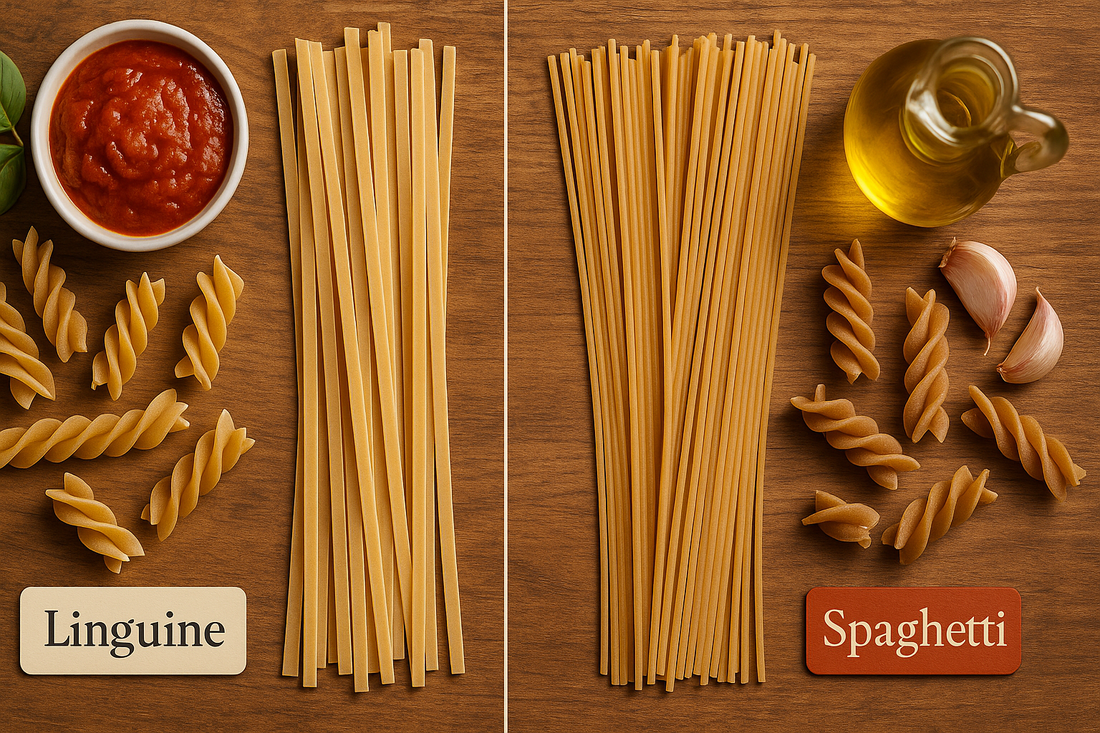Long pasta is long pasta… right? Not quite.
While linguine and spaghetti may look similar at first glance, each has its own character — and choosing the right one can seriously upgrade your next meal.
Let’s break down how these two shapes differ in texture, sauce pairing, and even nutrition, especially when made the traditional way using durum wheat pasta and bronze-cut methods.
What Exactly Is Spaghetti?
Spaghetti is the most iconic pasta in the world. Long, thin, and round like little strings, it’s simple, versatile, and perfect for everything from tomato sauces to olive oil tosses. The word “spaghi” comes from Italian and literally means “thin cords,” — which describes its shape exactly.
What makes spaghetti stand out isn’t just its familiarity, but how well it works with nearly any sauce. The smooth, round strands cook evenly and twirl beautifully around a fork, making it a favorite for pasta lovers of all ages.
When made from 100% whole durum wheat semolina, spaghetti delivers more than just taste — it offers genuine health benefits. Because the whole grain is used (including the bran, germ, and endosperm), you get:
-
More fiber to aid digestion and help you feel full
-
Higher protein content to support muscle and energy
-
A lower glycemic index, for steady blood sugar levels
- Essential nutrients like iron, magnesium, and B vitamins
Pasta made with traditional techniques — such as bronze-cut shaping and slow drying at low temperatures — also holds sauces better and maintains a firm, al dente texture when cooked.
Best Sauce Matches:
-
Classic red sauces like marinara or arrabbiata
-
Simple olive oil and garlic for an easy Aglio e Olio
-
Light cream sauces or vegetable-based stir-fries
- Even cold salads with roasted veggies or herbs
Taste the Tradition. Twirl the Goodness. Choose Gustora Foods Whole Wheat Spaghetti – Where Authentic Meets Wholesome.
What About Linguine?
Linguine is a bit flatter and wider than spaghetti — think of it as long ribbons with more surface area. The name means “little tongues”, which perfectly describes its shape.
This design makes linguine ideal for sauces that need more grip, especially creamy or oil-based ones. When made the traditional Italian way using bronze dies and slow drying, linguine develops a slightly porous texture that’s perfect for holding onto sauce.
Choose a linguine that’s:
-
Made with durum wheat semolina
-
Bronze-cut for texture and sauce cling
-
Eggless and clean-label — just semolina and water
-
Dried slowly at low temperatures to preserve nutrients
This pasta shape pairs especially well with:
-
Creamy mushroom or Alfredo sauces
-
Lemon zest and olive oil
-
Basil pesto
-
Garlic butter seafood toppings
- Chili oil and herbs
Linguine's flat shape and slightly thicker body offer a heartier bite and more luxurious mouthfeel — perfect for fancy dinners or simple weeknight meals. If you're not sure whether to try linguine, check out our blog Exploring Pasta Varieties: Shapes, Textures, and Best Uses — where we explain how traditional shapes like linguine are meant to hold sauce and deliver flavor with every bite.
Elevate your pasta game with Gustora Foods Linguine — Where Authentic Italian Craft Meets Everyday Deliciousness.
Linguine vs. Spaghetti: Head-to-Head Comparison
|
Feature |
Spaghetti |
Linguine |
|
Shape |
Round, thin strands |
Flat, slightly wider ribbons |
|
Texture |
Smooth, chewy |
Slightly thicker, more surface area |
|
Sauce Grip |
Good with light sauces |
Excellent for creamy or oily sauces |
|
Best Used For |
Red sauces, stir-fries |
Seafood, creamy sauces |
|
Gustora Option |
Whole Wheat Spaghetti |
Linguine Bronze Pasta |
So, Which One Should You Choose?
It depends on your dish. If you’re cooking with thin or tomato-based sauces, spaghetti is a perfect match. If you want to try creamier or oil-rich sauces, linguine will serve you better.
Either way, choosing pasta made with durum wheat, bronze-cut shaping, and slow-dried methods will bring out the best in either shape — better flavor, better nutrition, and better texture.
This is what separates authentic Italian pasta (even when made locally in India) from mass-produced, overly refined noodles.
Want More Pasta Tips?
Explore our other pasta deep dives:
-
Artisanal vs. Commercial Pasta: What You Need to Know Before Buying — Discover how pasta-making methods impact flavor and quality
-
Is Whole Wheat Pasta Really Better? The Nutrition Breakdown — Compare whole wheat vs. regular pasta and why fiber matters
- Elbow vs. Penne: Which One Works Best in Creamy Pasta?
— Learn why pasta shape and texture aren’t just about looks
Final Thoughts: Which Pasta Wins?
So, linguine vs. spaghetti — what’s the verdict? Honestly, both are winners. The right choice depends on your recipe.
Choose:
-
Spaghetti for light sauces, stir-fries, and comfort meals
- Linguine when you want sauce to coat every bite or are making seafood, pesto, or creamy recipes
Either way, pick pasta that’s made with care — like durum wheat semolina pasta, bronze-cut, and slow-dried for better texture, nutrition, and flavor.
Because when the base is good, even the simplest pasta dish becomes unforgettable.
FAQs About Linguine vs. Spaghetti
-
Is one healthier than the other?
Not really — it depends more on the ingredients used. Look for whole wheat pasta or high-protein pasta made from durum wheat for the best nutritional value. -
Can both be used interchangeably?
Yes, but the sauce makes the difference. Use spaghetti for thinner sauces, linguine for thicker or oil-based ones. -
Are both pasta types vegan?
They can be! Many clean-label brands offer eggless pasta using only semolina and water. -
Does bronze-cut pasta really make a difference?
Absolutely. Bronze dies give pasta a rough texture that holds sauce better and offers a more satisfying bite.


